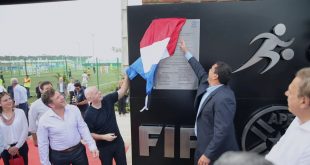 In the five years since Nike, Eliud Kipchoge and the revolutionary Alphafly did the unthinkable — breaking the barrier of the two-hour marathon — the company has been hard at work.
In the five years since Nike, Eliud Kipchoge and the revolutionary Alphafly did the unthinkable — breaking the barrier of the two-hour marathon — the company has been hard at work.
New research, advanced capabilities and a bold innovation agenda led the brand to evolve its super shoe Alphafly line to the Alphafly 3, a shoe to serve all marathoners, at all levels. Now, Nike is optimizing its proprietary Air technology — one of the three key ingredients in its super shoe “system of speed” — to bring super-charged results to athletes on the track, court and pitch.
“When the Alphafly hit it shocked everyone with the intro of Air Zoom,” says Tony Bignell, Vice President, Running Footwear. “It was polarizing, but with our expert research in the worldclass Nike Sport Research Lab along with validation from Eliud Kipchoge, the world’s greatest marathoner, we had the proof that it was efficient, responsive and gave such energy back — it was the best in the industry. This system of speed — our ZoomX foam, carbon plate and Air Zoom units — continues to be Nike’s competitive advantage.”
Since Eliud and the legendary Nike Alphafly prototype crossed the marathon finish line in 1:59:40, the Alphafly 3 has evolved to become the lightest model yet and more precisely tuned. The Nike Alphafly 3 updates the shoe’s split sole to a continuous bottom that connects the heel and forefoot; now, no matter where a runner’s foots strikes, they get a smooth transition, regardless of pace. The Alphafly 3’s featherweight form comes from listening to its largest testing pool ever — ranging from everyday to elite marathoners — throughout the design process, from feedback on early 3D renderings to in-hand prototypes. Thanks to notes from athletes like Eliud, Nike designers carved away foam in the Alphafly’s midsole and heel to put it only where runners need it, helping to concentrate the load on the forefoot Air Zoom units so all runners could better activate them.
Throughout the Alphafly’s evolutions, there is only one technology that hasn’t changed: Air Zoom. “We’ve fine-tuned the other elements of the shoe so that you get better engagement with the two Air units in the forefoot, ultimately letting Air do more of the work for you,” says Bignell. Proof that when you’ve got something that works, you don’t change it — you enhance it.
That logic’s paid off. In the 2023 Chicago Marathon, running in the Alphafly 3 prototype during its official development window, Nike athlete Sifan Hassan clocked the second fastest women’s marathon ever and the late Nike athlete Kelvin Kiptum set the new men’s marathon world record.
Nike’s adapted its system of speed, powered by Air, to help its iconic roster of track athletes crush records in distances ranging from sprints to distance track events.
Air Zoom units first arrived in Nike track spikes in 2020, bringing game-changing cushioning innovation to athletes for the first time. For Paris 2024, the Nike Maxfly 2 — Nike’s spike designed for sprinters racing 100m to 400m — and the Nike Victory 2 — Nike’s middle distance spike designed for athletes racing 800m to 1500m — now have a flatter ground-facing profile offering a more stable ride with more ground contact, while still giving that pop of energy return only Nike Air can provide. Pronounced diagonal lines, acting as a base of support on the medial side, contribute to the stabilization of both the new Maxfly 2 and Victory 2, allowing athletes to benefit from the full force of their foot strike while offering stability on the track’s curve.
“Nike Air technology isn’t just changing how fast athletes can run — it’s changing the sport of track and field,” says Dr. Emily Farina, principal researcher in the NSRL. “With the introduction of Air Zoom in the Maxfly and Victory, athletes had cushioned spikes that actually inspired some people to try distances that they previously would not run.”
As for Air’s effectiveness, last year’s stats speak for themselves: In 2023, track and field and marathon athletes notched nine new World Records — and Nike athletes accounted for eight of them, and in running distances from the 1500 meter to the marathon. What’s more, at the 2023 World Outdoor Track & Field Championships, 50% of the medals went to Nike athletes.
Nike applies its proprietary technology with precision and creativity. “There is so much you can do with Air — it can be the most protective cushioning system and also stretch to be the most responsive cushioning system,” says Leo Chang, Senior Director, Running Footwear Product Design Innovation. “We have all these different Air unit shapes and inflations because those shapes and sizes matter, whether you’re a person with a lower body mass who needs more engagement from Air or you’re in a sport or event that has a specific need.”
Nike researchers know that basketball players want maximum energy return from tip-off to buzzer. With that need in mind, they’ve created the new G.T. Hustle 3.
Everything about the development of the shoe came back to increasing energy return for the athlete, hitting the right weight and enhancing overall comfort, says Nike Principal Researcher Dr. Elysia Davis. The result: “Nike can definitively say ‘the G.T. Hustle 3 saves you energy,’’ Davis says. “Our Nike Sport Research Lab (NSRL) found that an athlete consumes less oxygen wearing the G.T. Hustle 3 than if they were doing the same amount of work wearing the G.T. Hustle 2.” Those validated savings are significant to any player, she adds, whether you’re pro or playing pick-up.
Key to these science-backed results is a new Nike Air Zoom unit in the forefoot designed for the demands of basketball. This new Air Zoom unit combines with a sewn-in Nike Air Zoom strobel to create a double-stacked layer of Air underfoot for enhanced energy storage and return. The Air Zoom in the forefoot is partnered with a soft and resilient heel, along with a higher offset, to promote a smooth heel-to-toe transition. In the upper, Nike Radial Knit, a new soft, lightweight, breathable knit, delivers zonal containment and support without adding weight.
A unique part of the G.T. Hustle 3 story: Nike’s NSRL research for the shoe was women-led from the start.
“I think there is a powerful story here about innovating for women — doing so doesn’t mean creating a separate shoe, in a different color,” says Davis. “It’s about listening to women’s perspectives of sport and tuning into the descriptive feedback they give. What this enables us to do is not make the best women’s basketball shoe, but the best basketball shoe, period.”
To meet the needs of its global football athletes, Nike took the same Air innovation and execution from running on the court to running on the pitch — and not without overcoming obstacles.
One challenge: Constraint. On the court, athletes need to run, jump and cut, and the cushioning from a Air Zoom Unit can stack higher to achieve it — 30mm in the G.T. Hustle 3. But on the pitch, athletes need to be as low as possible to the turf and able to quickly stop and accelerate and cut in any direction on soft ground that absorbs energy. Add on the challenge that, traditionally, footballers viewed a stiff, hard boot as a better-constructed boot; adding cushioning was thought of as literally and figuratively soft.
To devise Air for a footballer, the Nike solution was to store energy in a small package. This meant creating a 4 mm Air Zoom Strobel. In 2022, the Mercurial franchise reintroduced Air Zoom to football with the first football-specific Air unit, and the results were overwhelming. Nike athletes were floored with how they could get such energy back from the pitch. Athletes’ trust in the brand enabled the company to introduce the innovation and see successful adoption.
For Paris this summer, the Nike team set out to unlock how to make its fastest boot even better for its athletes. Fine-tuning its Air innovations, the Nike 2024 Air Zoom Mercurial delivers 10% more energy return than the boot’s predecessor.
Again, the Nike teams pulled it off by optimizing Air. Flex grooves were removed from the Air Zoom Strobel unit and tuned flex zones were added to the underfoot of the 2024 Mercurial. Removing the flex grooves allowed for optimal rebound, while the addition of tuned flex zones in the forefoot was designed to increase the athletes’ engagement with the Air Zoom. Underfoot, the 2024 Mercurial’s plate and stud design were also designed to allow for more engagement with the Air unit in the midfoot while also having that tried-and-true Mercurial traction. Plus, the chevron and blade stud pattern allows athletes to efficiently move in all directions and cut on a dime while quickly moving around the pitch.
Many footballers stress how important it is for their boot to feel like a natural extension of their foot, and that they perform their best when the boot moves with them and not against them. Listening to the athlete, Nike obsessed over making the fit of the 2024 Mercurial as sculpted as possible. The team reduced the upper from five layers of material to three, making the boot softer and lighter. This cut the upper’s thickness by nearly 30%, so it could more easily mold to the athlete’s foot, creating a more natural feel.
Finally, the engineered lining was strategically placed in the boot to ensure ample lockdown where players need it most. And where they don’t need grip and lockdown, Nike introduced AtomKnit — a durable, lightweight yarn commonly used in the brand’s elite track and field spikes. This helps shave weight to keep players even lighter on their feet.
As for the future of Air? It’s happening right now, as Nike leverages the latest in artificial intelligence (AI) and advanced digital tools to co-create bespoke, one-of-one products with its athletes through A.I.R. — Athlete Imagined Revolution. A.I.R. is a co-creation with 13 visionary athletes, imagining the future of Air. By deftly using AI and algorithmic tools and harnessing uniquely Nike scientific expertise, creative empathy and design curiosity, with A.I.R., Nike is not just listening to its athletes, it’s amplifying their potential.
As Nike’s Chief Innovation Officier John Hoke puts it, “A.I.R. is driven by hyper-personalization, boundless collaboration and unparalleled creativity, with infinite possibilities. We’re unlocking new heights of innovation by harnessing the power of data, design and dreams. We’re introducing a groundbreaking new era of sport — a fusion of art and science where innovation knows no bounds.”
 Arunava about Football A look at football & the world through my eyes!
Arunava about Football A look at football & the world through my eyes!



